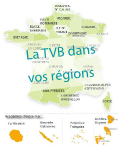A bit of history...
...at the European and international level
At the European level, France is the 19th country to implement an ecological network throughout its territory. Some countries like the Netherlands, Lithuania and Estonia started working on these issues as early as the 1970s. In 1995, members of the Council of Europe, including France, signed the Pan-European Biological and Landscape Diversity Strategy, whose main objective was to create the Pan-European Ecological Network.
Establishing the TVB in France is a response to the Pan-European Ecological Network in particular and is in line with the objectives of the new EU 2011-2020 Biodiversity Strategy (especially Target 2).
Since 2013, the European Commission has encouraged Member States to develop "Green Infrastructure" (GI, similar approach to the French concept of TVB) and promote investment in this area. GI is eligible for ERDF funding.
After approving the mid-term report of the 2020 strategy, the EU Council of Ministers for the Environment mandated the European Commission to establish a trans-European network of ecological continuities by 2017. To this end, France is actively contributing to mobilising partners and to the work of the Commission.
he TVB also directly contributes towards two Aichi targets (of the strategic plan 2011-2020 of the convention on biological diversity: target 11 concerning ecologically representative and well-connected systems of protected areas and target 15 related to the restoration of 15% of degraded ecosystems.
Finally, the TVB contributes to implementing the biodiversity conservation objectives set by the Alpine Convention. In this context, France endorses the Alparc initiative (Alpine Network of Protected Areas), which supports implementation of this convention.
… in France
Before the TVB policy and SRCEs were even established, a number of public authorities (regions, departments, regional natural parks, inter-municipalities and municipalities) worked on the issue of ecological continuities and have incorporated them into their territorial policies and planning documents.





